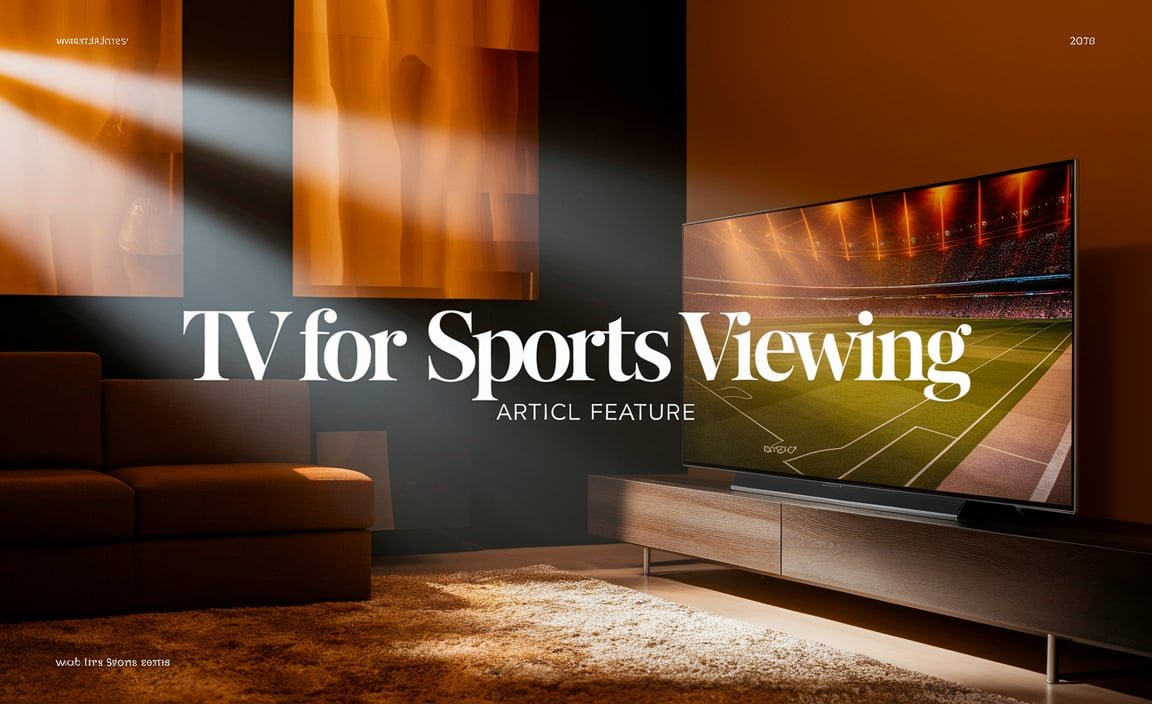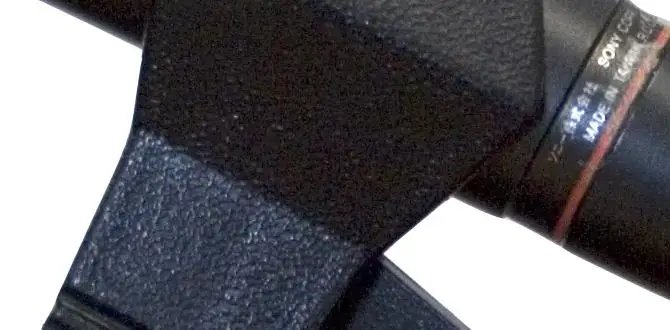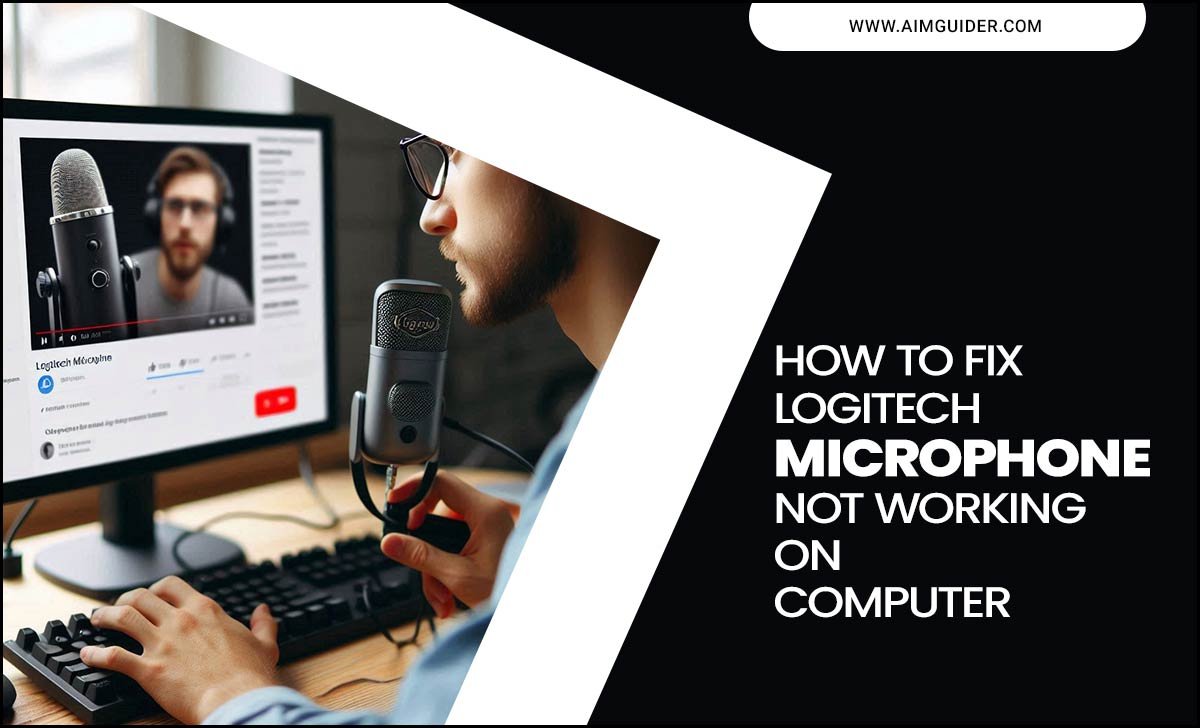Find the best TV for PS5 gaming on a budget without sacrificing essential features. This guide simplifies your search, highlighting models with low input lag, 120Hz refresh rates, and vibrant colors that enhance your PlayStation 5 experience without breaking the bank. Get ready for smoother gameplay and stunning visuals, even on a tight budget.
So, you’ve got your shiny new PlayStation 5, ready to dive into epic games. But wait, is your current TV doing it justice? Playing fast-paced games like Spider-Man: Miles Morales or Elden Ring on an older, slower screen can be frustrating. You might notice blurry motion, delayed reactions, and colors that just don’t pop like they should on the PS5. It’s a common problem for gamers looking to upgrade their setup without spending a fortune on the latest, most expensive TVs. Don’t worry, finding a great TV that complements your PS5 and your wallet is totally achievable. We’re here to guide you through exactly what to look for and suggest some fantastic, budget-friendly options.
Why the Right TV Matters for PS5 Gaming
The PlayStation 5 is a powerful console, capable of pushing graphics and frame rates that demand a capable display. Simply put, a good TV can make the difference between a jaw-dropping gaming experience and a frustrating one. When we talk about gaming on a PS5, a few key features stand out as being particularly important:
- Input Lag: This is how long it takes for your TV to display what your controller does. Lower is better! High input lag means you press a button, and there’s a noticeable delay before it happens on screen. This is critical for reaction-based games.
- Refresh Rate: Measured in Hertz (Hz), this tells you how many times the screen updates per second. For smoother motion, especially in fast games, 120Hz is the sweet spot. The PS5 can often output games at 120 frames per second (fps), but your TV needs to be able to keep up!
- HDMI 2.1: This is the latest HDMI standard. It’s important because it supports features like 4K resolution at 120Hz, Variable Refresh Rate (VRR), and Auto Low Latency Mode (ALLM), all of which are designed to give you the best gaming experience.
- Color and Contrast: While specs are crucial, a TV also needs to display vibrant colors and deep blacks to make games look their best. Think HDR (High Dynamic Range) support.
What to Look for in a Budget PS5 TV
When your budget is tight, you have to be smart about where you focus your spending. Not every feature of a high-end TV is absolutely essential for a great PS5 experience, especially if you’re prioritizing affordability. Here’s a breakdown of what’s most important:
The Absolute Must-Haves (Even on a Budget)
- Low Input Lag: This is non-negotiable for responsive gameplay. Aim for a TV with a “Game Mode” that reports an input lag of 20ms or less. Many reviews will specifically test this!
- Good Motion Handling: While 120Hz is ideal, some TVs with a 60Hz panel can still offer decent motion if they have fast response times and good de-blurring features. For the absolute best smooth visuals, especially with PS5’s 120Hz capabilities, a 120Hz panel is preferable.
- HDMI Port Availability: Ensure the TV has at least one HDMI port that can handle 4K @ 60Hz. If you can find one with an HDMI 2.1 port within your budget, that’s a major bonus for future-proofing and accessing advanced PS5 features.
Nice-to-Haves (If You Can Find Them)
- HDR Support (HDR10, HLG): Even basic HDR implementations can make colors more vivid and add depth to images, making games look more lifelike.
- VRR and ALLM: These HDMI 2.1 features are excellent for gaming, reducing screen tearing and ensuring the TV is always in its lowest latency mode. They become more common as TV prices drop.
- Good Built-in Speakers: Most TV speakers are mediocre at best, but if you’re on a super tight budget and can’t afford a soundbar, decent built-in audio can be a small but welcome perk.
Features You Can Probably Skip on a Budget
- 2.1 HDMI Ports on ALL Inputs: Many budget TVs will have one or two HDMI 2.1 ports, but not all. For PS5 gaming, you only need one for the console itself.
- Top-Tier HDR Formats (Dolby Vision, HDR10+): While nice, these are often found on more expensive TVs and add significant cost. You can still enjoy good HDR with HDR10.
- Extremely High Brightness Levels: Very bright TVs are great for HDR impact, but are a premium feature. A TV with good contrast and color accuracy at moderate brightness is perfectly fine for budget gaming.
Understanding Key Gaming TV Terms
Let’s quickly break down some terms you’ll see when looking at TV specs that are important for gaming. Think of this as your cheat sheet!
- Input Lag: The delay between an action on your controller and its appearance on screen. Measured in milliseconds (ms). Lower is always better.
- Refresh Rate: How many times the screen image updates per second. Measured in Hertz (Hz). 60Hz means 60 updates per second, 120Hz means 120 updates per second – resulting in smoother motion.
- Response Time: How quickly a pixel can change color. Faster response times reduce motion blur.
- 4K UHD (Ultra High Definition): A resolution of 3840 x 2160 pixels, offering much sharper and more detailed images than 1080p (Full HD).
- HDR (High Dynamic Range): A technology that expands the range of colors and contrast a TV can display, leading to more lifelike and vibrant images. Common formats include HDR10, HLG, Dolby Vision, and HDR10+.
- HDMI 2.1: The latest HDMI standard that supports higher bandwidth, enabling features like 4K at 120Hz, VRR, and ALLM.
- VRR (Variable Refresh Rate): Allows the TV’s refresh rate to sync with the game’s frame rate output from the console. This eliminates screen tearing and stuttering for a smoother visual experience.
- ALLM (Auto Low Latency Mode): When the PS5 detects a game is being played, it signals the TV to automatically switch to its Game Mode for the lowest possible input lag.
How to Find Deals: Smart Shopping Strategies
Scoring a great TV for your PS5 on a budget isn’t just about finding the right model; it’s about smart shopping. Here are some tips toStretch your dollar further:
- Shop During Sales Events: Major sales like Black Friday, Cyber Monday, Prime Day, and holiday weekends are prime times to find significant discounts on TVs.
- Consider Previous Year’s Models: Retailers often discount last year’s TV models heavily to make way for new inventory. These TVs often still have excellent features and performance for gaming.
- Look for Refurbished or Open-Box Deals: Many reputable retailers offer certified refurbished or open-box items at a discount. These products are usually tested, come with a warranty, and can be a great way to save money. Always check the return policy and warranty period.
- Compare Prices Across Retailers: Don’t settle for the first price you see. Use price comparison websites and check major retailers like Amazon, Best Buy, Walmart, and others.
- Sign Up for Email Lists: Many electronics retailers offer exclusive discounts or early access to sales for subscribers.
- Buy Slightly Smaller Screen Sizes: While a huge screen is tempting, moving down just one or two inches in screen size (e.g., from 65″ to 55″) can sometimes drop the price significantly while retaining similar picture quality and gaming features.
Our Top Picks for Best Cheap PS5 TVs (Under $500 – $700 Range)
Finding a TV that hits all the PS5 requirements at a truly “cheap” price point can be challenging, as HDMI 2.1 and 120Hz panels are still premium features. However, we can find excellent TVs that offer superb gaming performance for their cost, often in the sub-$700 range, especially when on sale. These models prioritize essential gaming features like low input lag and good motion handling. The PS5 is backward compatible with 4K at 60Hz, so even a great 60Hz TV can offer an amazing experience if its input lag is low enough and its picture quality is good!
It’s important to note that prices fluctuate. The ranges provided are approximate and based on typical sale prices for common screen sizes (e.g., 50-55 inches). Always check current pricing at major retailers.
1. TLC 5-Series / 6-Series (QLED Roku TV)
TLC’s QLED TVs, particularly their 5-Series and sometimes the 6-Series when on sale, consistently offer fantastic value for money. They often incorporate QLED technology for brighter, more vibrant colors and better contrast than standard LED TVs. Depending on the specific model year and sales, you might even find HDMI 2.1 ports and 120Hz panels in some of these, especially the higher-tier 6-Series.
Pros:
- Excellent color and brightness for the price (QLED technology).
- Generally good input lag, especially with Game Mode enabled.
- The Roku TV smart platform is user-friendly and comprehensive.
- Often a good balance of features for gaming and general viewing.
Cons:
- HDMI 2.1 and 120Hz are not guaranteed on all models, especially the 5-Series. You need to check specific model numbers.
- Picture processing isn’t as sophisticated as premium brands.
- Local dimming can be inconsistent on some lower-end models.
2. Hisense ULED U6K / U7K Series
Hisense has become a serious contender in the budget-friendly TV market, offering a lot of bang for your buck. Their ULED TVs compete directly with QLED panels from other brands. The U7K series, in particular, is often lauded for bringing HDMI 2.1 features like 120Hz, VRR, and ALLM to a more accessible price point, making it a very compelling option for PS5 gamers on a budget.
Pros:
- Often includes HDMI 2.1 with 4K@120Hz, VRR, and ALLM even on mid-range models (check U7K specifically).
- Good brightness and color reproduction (QLED/ULED technology).
- Competitive pricing for the features offered.
- Overall solid gaming performance with low input lag.
Cons:
- Smart TV platform (Google TV or VIDAA) can sometimes feel a bit clunky compared to Roku or Google TV on TCLs.
- Motion handling can be good but not always class-leading.
- Build quality might not feel as premium as higher-priced models.
3. Samsung QLED (Q60/Q70 Series – Older Models are Key!)
Samsung’s QLED technology offers vibrant colors and good brightness. While their newest high-end QLEDs are expensive, you can often find older models of the Q60 or Q70 series (like Q60B, Q70B, or even Q60A, Q70A) at significant discounts, especially during major sale events. These older models, particularly the Q70 series, were known for including HDMI 2.1 ports and 120Hz panels, making them excellent budget gaming TVs when found on sale.
Pros:
- Vibrant colors and good peak brightness thanks to QLED.
- Excellent motion handling.
- Older Q70 models often feature HDMI 2.1 and 120Hz.
- Samsung’s Tizen smart platform is fast and easy to use.
Cons:
- You’ll likely need to look for previous year’s models or sales to get these at a budget price.
- Contrast can be somewhat lacking compared to OLED or higher-end QLEDs.
- HDR performance is good but can be less impactful than more expensive sets.
4. Sony BRAVIA XR (X80K/X85K Series – Look for Sales!)
Sony is known for its excellent picture processing and natural-looking images. While Sony TVs can be pricey, you can sometimes find deals on their entry-level BRAVIA XR models, like the X80K or X85K series, particularly on slightly older versions (e.g., X80L, X85L). The X85K, in particular, was notably one of the more affordable TVs to offer 120Hz and HDMI 2.1 support, making it a great candidate if found on sale.
Pros:
- Excellent motion handling and upscaling.
- Natural color reproduction.
- Often features HDMI 2.1 ports with 120Hz support (especially X85 series).
- Google TV platform is robust and user-friendly.
Cons:
- Can be more expensive than competitors with similar specs, so sales are crucial.
- Contrast and black levels are not as deep as OLED or Mini-LED TVs.
- Peak brightness might be lower than some budget QLEDs.
5. LG Nanocell / QNED (Entry-Level Models on Sale)
LG’s Nanocell and entry-level QNED TVs offer good color and brightness. While their top-tier OLEDs are out of budget, you can sometimes find their more affordable LED/Nanocell/QNED models sporting features useful for gaming. Keep an eye out for sales, as these can often bring TVs with 120Hz panels and decent input lag into a more budget-friendly category.
Pros:
- Good color accuracy and decent brightness.
- LG’s webOS smart platform is intuitive and fast.
- Some models offer 120Hz and good gaming features at competitive prices when on sale.
Cons:
- Black levels and contrast can be weaker compared to higher-end TVs.
- HDMI 2.1 features might be more limited on lower-tier models.
- Performance can vary significantly between specific model numbers.
Essential TV Settings for PS5 Gaming
Once you’ve picked out your new TV, there are a few settings you’ll want to tweak to get the absolute best gaming experience without spending a fortune. Most of these are accessible on even budget-friendly TVs, especially when using “Game Mode.”
1. Enable Game Mode
This is the single most important setting for gaming. Game Mode significantly reduces input lag by skipping some of the TV’s image processing steps. You’ll find this in the picture or system settings menu. Some TVs support ALLM (Auto Low Latency Mode), which automatically switches to Game Mode when the PS5 is detected. Ensure this is enabled if available.
2. Adjust Picture Mode
Once Game Mode is on, you might be limited in your picture mode options. If you do have choices, “Game” is usually best. If “Game” isn’t available or you want to fine-tune, a “Standard” or “Movie/Cinema” mode can be a good starting point, but always prioritize low input lag. Avoid modes like “Vivid” or “Sports,” as they often increase input lag and can make colors look unnatural.
3. Fine-Tune Brightness and Contrast
While you don’t need a super-bright TV, making sure you can clearly see details in both dark and bright areas is key. Adjust the “Brightness” (or “Black Level”) to ensure you can see dark details without crushing them into blackness. Adjust “Contrast” and “Backlight” to make the image pop, but be mindful that increasing contrast too much can wash out details.
4. Color Settings
For most budget TVs, the default color temperature and saturation in Game Mode will be pretty good. If you have adjustments, aim for “Warm” color temperature settings if available, as they tend to be more accurate than “Cool” settings, which can make the image look too blue. Don’t go overboard adjusting saturation; keep it natural.
5. Motion Settings (Use with Caution)
Features like “Motion Smoothing,” “Noise Reduction,” or “Motion Interpolation” can make games look smoother, but they almost always increase input lag.





